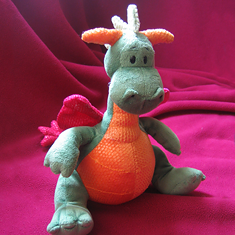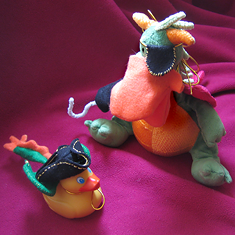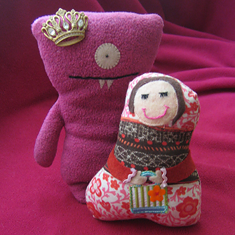So I spend a lot of time with my monsters.
Sometimes I have negotiators or moderators. Sometimes my monsters get cookies. Sometimes they don’t (not all monsters like cookies).
And it seemed appropriate to give some more information about the what, why and how of monsters, in case you want to talk to some of yours.

So. What is a monster?
Internal criticism. Old stuckified beliefs about what is true (like the outsider complex).
Anything you think to yourself (or about yourself) that hurts.
But why monsters? I don’t want monsters!
You don’t have to have monsters, sweetie. Of course not!
Some people talk about the Inner Critic. Tapes. Pictures. Voices. Stories. Narrative. Gremlins. Someone I know has flock of birds — the Flock of Stuck. Fi has her goblin (Mike). And, of course, Jung knew about the shadow.
These all work. Substitute whatever you like when I say “monster” — it’s okay by me.
The reason I go with monsters is this: as metaphors go, this one has helpful elements. Enough to make Metaphor Mouse proud. Because the monster metaphor is about transformation.
Here’s what pretty much always happens.
When you’re working on a stuck or sitting with a hurt or working through the layers, you eventually discover that your stuck just wants to protect you.
Your monster means well. It’s just going about it all wrong
Your monster is small and vulnerable and fuzzy. And it just wants to know that you’ll be okay. And that’s why it makes itself so big and fierce — to scare you into letting it take care of you.
And once it knows that you know, it can turn into something else.
When we actually interact with our monsters (and recognize their intentions, while still letting them know that it is not okay to keep freaking us out like that), they change shape.
From big, bad wolves and scary, menacing shadow creatures … into pocket-sized playthings with enormous googly eyes.
From that sense of dread because ohmygod something horrible is Right Behind You … into Sulley from Monsters, Inc.*
* Best tagline ever: “We Scare Because We Care”.
From Max‘s initial impression of the Wild Things roaring their terrible roars and gnashing their terrible teeth … to his realization that they can’t hurt him.
They’re just fuzzmuffin furball playmates, as vulnerable to loneliness and hurt as he is.
Talking to your monsters is all about witnessing this transformation.
And really, being the one who initiates that transformation by showing up and being genuinely curious about the monster and your relationship with it.
We don’t kill monsters. Or hunt them. Or scare them.
We talk to them.
We let them know what we need to feel safe and supported and loved.
We find out what they need. Where their safety is.
We are curious about them. We are curious about ourselves.
I don’t mean to imply that they’re not scary. Because they are.
It’s super important to acknowledge the scariness of the scary (because encountering a monster really is terrifying).
And that has to happen before we can recognize whatever good intentions or old, out-of-date defense mechanisms might be behind the scary.
Eventually you might realize that whoah, your monster is a total sweetiepie fuzzball. Or that might never happen. Either way, we start with noticing how uncomfortable it is to be frightened.
That’s the starting point. Permission to be scared. And to ask for help. And to have other people stand up for you to negotiate and document the experience.
Would you like to meet some of my monsters?
Obviously you’ve already met my fear and my hurt and my anxious and my stuck.
But some of the physical representations of monsters who live in my house.
This is Diki.
Rawr.
He is a very menacing dragon.
And on the right he’s dressed as a pirate duck. Along with Selma who’s dressed as a pirate dragon. For Purim.
(Thanks, Elizabeth the Bee for surprising us with hand-made costumes! You rock!)


Schmooasaurus is below left. He is a super-schmoo.
That’s Miflatzon at bottom right. Pictured here with his girlfriend Sophie, who is French (and not a monster at all).
He is my little Monsterchen!


Please note him rocking the sovereignty crown, which was a present from Deborah.
It’s not that all monsters are as cute as these guys.
Certainly most of mine aren’t. *shudders*
When we’re in the scary, we’re really in it.
And so I don’t in any way mean to imply that the fear isn’t legitimate or that our perception of how mean they are is wrong.
Of course not.
Just that the more we actively learn about our monsters, the easier it is to recognize their hidden motivations. And their extreme fuzziness.
I keep the monsters I already know around so that I can remember how something that used to terrify me is now familiar.
So that I can remember how I used to believe my monsters when they said I wasn’t a writer. Or when they told me I would fail miserably.
I can remember how useful it was to discover that they were just trying to keep me from getting hurt. And what happened when I stopped being impressed by them.
Some of them went away. Or morphed into other things. And some of them became schnoogly friends who sit at my side while I write to you.
You do not have to like your monsters.
You do not have to become friends with your monsters.
You don’t have to be grateful for them or appreciate them or anything. Blech. Not required!
There are no shoulds in monster-watching.
You get to have negotiators and protectors. You get to have support and love. You get to have hand-holding when you want hand-holding and to be left alone when you want to be left alone.
The point of the watching isn’t to scare you. Or them.
The point of the watching is to find out what happens when you bring attention to your world and your experiences.
And maybe to be surprised.

Comment zen.
We all have our stuff. We’re all working on our stuff.
We try to be patient while interacting with our stuff. We don’t throw shoes or give advice. And, of course, we give everyone’s monsters or non-monsters lots of room to be what they are.
*blows kisses at Commenter Mice and all the Beloved Lurkers*

 Follow
Follow
This makes me think of the phantoms from the Paradox Series by Rachel Bach that I just read. (Spoilers ahead if you plan to read the books)
Big lost monsters who are able to destroy entire WORLDS just by existing. But all they want to do is go home where they can eat and be safe and full and happy.
I’m gonna have to adopt this metaphor.